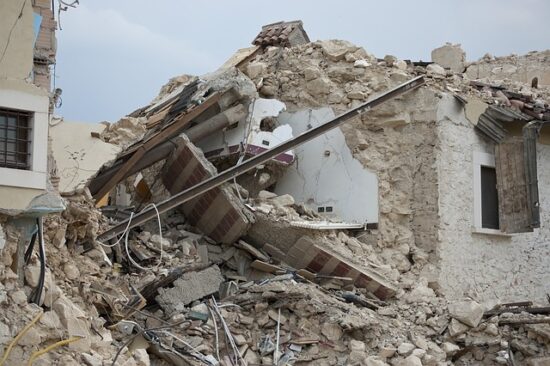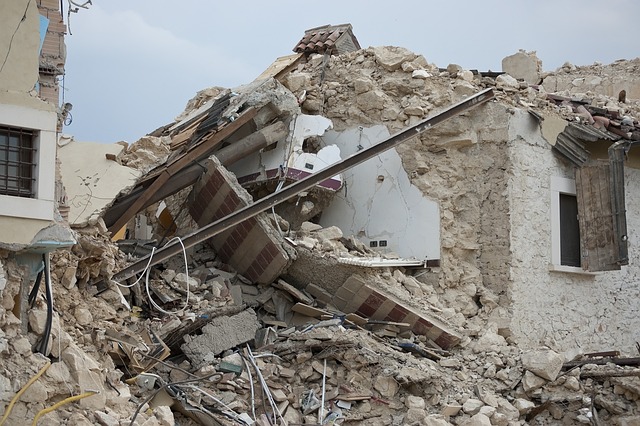What is an Earthquake
In general, earthquake refers to any volcanic activity which results in producing seismic waves. When rocks deep inside the earth are caused to experience a lot of stress due to tectonic forces acting on them. As a result of this severe stress, these rocks undergo a change in their shape and store energy within them. Now as these deformed rocks come back to their original shape, they release energy on their return. This energy is in the form of waves called seismic waves. Thus, these waves cause the earth to shake, leading to an earthquake.
This theory that explains how energy is stored inside rocks when they deform as they are caused to undergo extreme force and then release energy upon coming back to their original position is known as elastic rebound theory.
Illustration
The cause of an earthquake is similar to the bending of a flexible stick. When you twist a stick at its maximum point so much so that it may snap off once you push it any further, it will store energy inside it. Now as soon as you let it free, it gets back to its original shape releasing the energy in the process.
Terms and Definitions
- The bending of rocks into a new position is known as strain.
- The point (inside the earth’s crust) from where the energy of the rocks is released due to volcanic activity is called focus. It is also known as hypocenter and it refers to the precise location of an earthquake.
- The point that lies directly above the focus and on the surface of the earth is known as epicenter.
- The field of science that studies earthquake and seismic waves is called seismology. The scientist who examines earthquake and follows a line of inquiry into this discipline is known as seismologist.
- The scientific devices that record vibrations of the earth are called seismometers.
- The energy released by an earthquake (in the form of seismic waves) is usually assigned a specific magnitude number so that the precise amount of released energy can be calculated. The device that designates this number is known as Richter magnitude scale.
- The size of earthquake is measured by calculating the amount of energy released by it. The instrument that measures its size is called moment magnitude scale.
- When a volcanic activity or earthquake occurs beneath the body of water, a huge mass of water is displaced and in this way it gives rise to a series of waves known as Tsunami. It is also called Tidal Wave.
- The distance from the epicenter downward up to a point of focus is called focal depth.
- At times, an earthquake of relatively smaller magnitude occurs in the same location where main earthquake has just taken place. This smaller earthquake is referred to as aftershock.
- If one earthquake sparks off several other big earthquakes in the same location, this phenomenon is known as earthquake storm.
- The intensity of the earthquake varies according to the depth of the hypocenter. The deeper an earthquake is, the less likely it is to cause any damage and vice versa.

Tectonic Plates
- When the crust is merged with the uppermost part of the mantle, it forms lithosphere. The lithosphere is divided into a number of pieces called tectonic plates. Majority of earthquakes take place along boundaries of tectonic plates.
- Tectonic plates are attached with one another like pieces of a jigsaw puzzle. At times, one of the plates makes an effort to slip over the adjacent plate and like so the strain develops. This process in which one plate glides over another eventually results in producing seismic waves. This type of an earthquake is known as interplate earthquake.
- Almost 90 percent of the total seismic energy is released through interplate earthquakes.
Seismic Waves
- When earthquake occurs within rocks of the Earth’s crust, it emits energy in the form of waves. The frequency of these waves is low as they pass through three layers of the earth (The Crust, The Mantle and The Core). These waves are called seismic waves. It is only because of these waves that we get to know that earth’s interior is composed of three layers.
- Scientists believe that less than ten percent of the energy given off by an earthquake is in the form of seismic waves. Much of the rest of the energy is transformed into heat energy.
- The very first wave a seismograph records is called P-wave. The letter ‘P’ denotes ‘pressure’ or ‘primary’. The speed of these waves within solid rocks inside the earth is 6 – 7 km/s.
- The second wave to be recorded on a seismograph is known as S-wave. The letter ‘S’ denotes ‘secondary’ or ‘shear’. These waves are unable to pass through outer core (which is in molten state) but they can cross inner core (which is in solid state). The velocity of S-waves in the interior of the earth is slower as compare to P-waves. These waves travel at a speed of 4 – 5 km/s.
Earthquakes with a magnitude number of less than or equal to 3 are weak and cannot be noticed. The earthquakes having more than number 7 on magnitude scale are destructive and cause severe damage.
Types of Earthquakes
Based on focal depth, earthquakes are classified into three kinds.
- Shallow-focus earthquakes are those quakes that occur less than 70 km deep inside the earth. Thus their focal depth is less than 70 kilometers.
- Intermediate-depth earthquakes are those that lie between 70 km and 300 km deep. They are also known as mid-focus earthquakes.
- Deep-focus earthquakes develop inside the mantle and vary from 300 km to 700 km.
Location of Earthquakes
- The location with maximum number of earthquakes lies in the Pacific Ocean and is called Ring of Fire. It is 40,000 km long and consists of more than 75 percent of the volcanic eruptions of the world. Almost 90 percent of the underground eruption in the world takes place in this region. It is the world’s most active volcanic region.
- The second most active region of volcanic activity is called Alpine-Himalayan orogenic belt. About 17 percent of the biggest earthquakes of the world lie in this area.
- The world’s third most active area for volcanic activity is Mid-Atlantic Ridge.
Human Causes of Earthquakes
There are four kinds of human actions that may also trigger earthquakes. These are:
- When huge amount of water is collected to the backside of dams;
- when making a hole deep inside the ground and inserting liquid into the wells;
- when digging ground for extracting coal from deep inside the earth;
- when digging out oil from the earth.
More Earthquake Facts for Kids
- The energy released by a single earthquake is so great that it amounts to energy released by tens of thousands of nuclear bombs.
- Every year, our planet experiences more or less 500,000 earthquakes. However, 400,000 of these earthquakes are so small that we cannot feel them.
- In U.S.A., the two states that experience most minor earthquakes are Alaska and California.
- From the year 1900 and beyond, about 18 earthquakes occurred with a magnitude ranges from 7 to 7.9 and thus these were termed as ‘major’ earthquakes, as per United States Geological Survey.
- With a magnitude of 9.5, the strongest earthquake of the world was taken place in Chile in May 22, 1960. It is known as ‘Great Chilean earthquake’.
- The earthquake with the most number of casualties in the world was occurred on January 23, 1556 in China. It took lives of about 830,000 people and this incident is now known as Jiajing earthquake.
Did you really find these earthquake facts for kids good enough? Is it what you’re looking for? Please comment and help us improving this article. Thanks for reading it.
Learn some more: Facts About The Earth


Leave a Reply